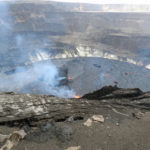Lava continues to erupt from multiple vents along the floor and western wall of Halemaʻumaʻu crater during Kīlauea’s current eruption. As of Sunday, October 3, 2021, all lava activity is confined within Halemaʻumaʻu in Hawai’i Volcanoes National Park. Seismicity and volcanic gas emission rates remain elevated.
Sulfur dioxide (SO2) emission rates remain high. Seismicity is elevated but stable. Summit tiltmeters continue to record deflationary tilt.
The lava lake surface has risen approximately 27 meters (89 ft) since the eruption started on Wednesday, September 29, 2001. The west vent continues to be the most vigorous source, with sustained lava fountain heights of 10-15 meters. The lava lake has risen to the base of the west vent, around which a cone is being built. Other vents including a 35-meter-long fissure continue to be active in the central and southern parts of the lake, with sustained lava fountain heights of 5-10 meters. Occasional fountain height bursts have also been observed. Due to the location of vents, the lava lake is not level across its surface. As of Sunday, October 3, the west end of the lake is 1-2 meters higher than the east end, and the south end is approximately 1 meter higher than the north end.
No unusual activity has been noted in the Kīlauea East Rift Zone. SO2 and hydrogen sulfide (H2S) emissions from Puʻuʻōʻō were below instrumental detection levels when last measured on January 7, 2021.
This new eruption at Kīlauea’s summit is occurring within a closed area of Hawai’i Volcanoes National Park. Therefore, high levels of volcanic gas are the primary hazard of concern, as this hazard can have far-reaching effects down-wind. Large amounts of volcanic gas—primarily water vapor (H2O), carbon dioxide (CO2), and sulfur dioxide (SO2)—are continuously released during eruptions of Kīlauea Volcano. As SO2 is released from the summit, it reacts in the atmosphere to create the visible haze known as vog (volcanic smog) that has been observed downwind of Kīlauea. Vog creates the potential for airborne health hazards to residents and visitors, damages agricultural crops and other plants, and affects livestock.
The best eruption viewpoints day or night are along Crater Rim Trail, and include Uēkahuna, Kīlauea Overlook, Wahinekapu (Steaming Bluff), Kupinaʻi Pali (Waldron Ledge), Keanakākoʻi and other overlooks. Visitors to Hawai’i Volcanoes National Park can expect to see a reddish orange glow in the dark the as the lava lake reflects into the gas plume wafting out of the volcano, and onto any clouds above the summit crater. In the daylight visitors should expect to see volcanic gas and steam billow out of Halemaʻumaʻu, and the entire summit caldera while Koaʻe kea, white-tailed tropic birds, are often observed flying above the crater. Visitors should be mindful that under southerly wind conditions, there is potential for a dusting of powdery to gritty ash composed of volcanic glass and rock fragments. These ashfalls represent a minor hazard, but visitors should be aware that dustings of ash at areas around the Kīlauea summit are possible.
Photo credit: USGS
